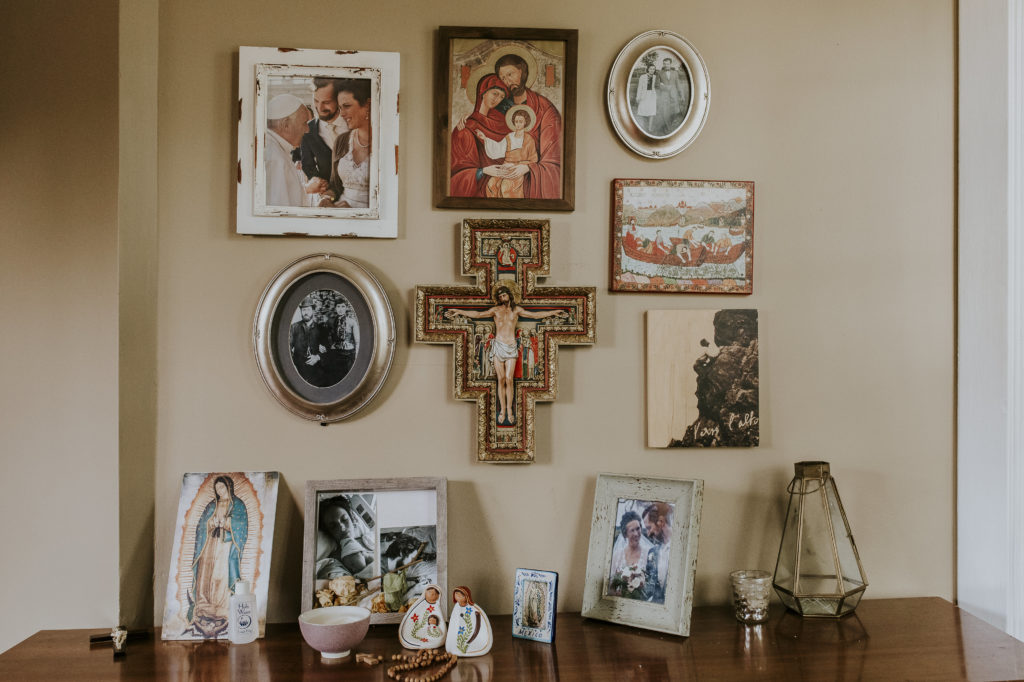Even though I discerned out of religious life years ago, marriage and motherhood have revealed to me a miniature monastic community to cultivate, one in my tiny Chicago apartment with my husband and daughter.
Like monastic life, family life has its own rhythms and repetition. And caring for a toddler has shown me that our collective sanity depends on our ability to make our home and prayer life a haven of simplicity and order. We’re definitely a work in progress, which means we can experience the joy of experimenting with various prayerful exercises to see which ones stick.
Here are some of the practices we’ve tried to incorporate into our family life, representing a variety of religious communities and a spectrum of spiritualities. May these ideas help you bring some ora et labora into the monastery of your home.
Monday: Make a family altar
For centuries, Catholic families kept altars in their homes as mindful spaces to use for prayer. This practice has largely been forgotten in our contemporary culture, but one need not be Chip or Joanna Gaines to bring it back. For my family, our altar is the top of a dresser where we’ve placed some candles and hung a crucifix and a few religious paintings. This has become the space for other religious articles we accrue: our Advent wreath, palms, my daughter’s baptismal candles. Your altar can be as simple or as ornate as you like; how it looks is less important than that it exists and serves as a space to collect, reflect and pray.
Going deeper: Read Little Oratory: A Beginner’s Guide to Praying in the Home, in which David Clayton and Leila Lawler write with the hope of “transforming the home into a little Eden.” They offer concrete instruction on how to prepare your home to live the liturgical life of the Church by creating “visible signs of spiritual awareness and devotion” around which you can structure your family’s prayer life.
Tuesday: Singing hymns
You know that toddler you see at Mass running from her parents toward the altar, yelling at the top of her lungs? That’s my daughter. Compliance is not her strong suit. But when the music starts, never has a more appropriate reaction been seen. She raises her arms with joy, sings, dances and applauds. My husband, Andrew, and I try to capitalize on this by incorporating song into our prayer routine. We pull out our guitar and banjo and our daughter’s Hello Kitty tambourine and maracas and have family jam sessions using our hymnal.
Going deeper: For those who like to play and sing, the Adoremus Hymnal has it all. Organized by everything from liturgical season to meters, this thick, 600-pager has everything you could ever want. For the less musically inclined, check out the hymn covers by your favorite artists. Sufjan Stevens, Mumford & Sons, Gillian Welch and countless others have covered timeless favorites with the same folksy instrumentals of their mainstream hits.


Wednesday: Liturgy of the Hours
Few things scream monasticism more than the Liturgy of the Hours. This meditative dialogue of the Church uses five canonical prayers that mark the day’s hours through scriptural proclamation and dialogue with Christ. Few family lives allow for praying together five times throughout the day, but many allow for a morning prayer when the family is gathered before breakfast or for an evening prayer when you’re tucked in bed with a spouse. The Liturgy of the Hours is a perfect tool for those drowsy parenting moments when you’re at a loss for words to pray.
Going deeper: Try a subscription to Magnificat, which provides morning, evening and night prayers in a digestible little magazine or app, along with Mass readings and daily reflections. If you’re not sure you’re ready to commit to a subscription, try the free Laudate app.
Thursday: Invite someone to dinner
Hospitality is a cornerstone of many religious orders and can be practiced from the humble quarters of your own home, particularly for a group of people often overlooked. Too often we forget that the priest at the pulpit or the sister in the pew is someone with whom we can build community, just as with any other parishioner. Show appreciation for the religious in your community through the simple act of inviting them for dinner. Throw your heart into hospitality the same way Martha’s sister Mary did with a bottle of perfume for Christ. Bake from scratch, set the table beautifully and strive to make your home a slice of heaven for whomever you’re inviting.
Going deeper: Get inspired by watching one of Pope Francis’ favorite films, Babette’s Feast. This Danish film follows a humble French servant, Babette, who wins the lottery and decides to spend her money on an opulent feast for her employers. Foodies will find the scenes of quail and caviar preparation mouth-watering, and everyone can enjoy the restorative healing created by this meal fit for a king.


Friday: The Adoration handoff
Ironic as it sounds, sometimes the best prayer activity you can implement within your family is prayer time alone. Carting children to Mass is a vastly different experience than the prayer time you spend in solitude, and the impromptu prayerful moment feels like a thing of the past once you become a parent. Prayer becomes something that needs to be scheduled. So, start an Adoration handoff. Pick one night a week to have alone time at Adoration while your spouse watches the kids, and then switch places.
Going deeper: Therealpresence.org has compiled a list of all perpetual Adoration chapels in the United States.
Saturday: Cultivate silence
Without realizing it, we saturate our lives with noise — and we transfer this appetite for incessant stimulation to our children. Fight that temptation to entertain by finding times to opt for silence. Challenge yourself to turn off the radio for a car ride. Don’t offer your child the iPad on every road trip. If the only topic you can think to bring up at dinner is someone else’s business, choose to say nothing at all. When you resist the urge to constantly engage your children, you’ll find the irony is that it will be easier for them and harder for you.
Going deeper: The award-winning film Into Great Silence documents the lives of Carthusian monks who have taken a vow of silence. Watching it is like taking a bath in monastic life, and we hear the silence we choose to take for granted in the everyday moments of our own lives.


Sunday: A different kind of fast
A lot of industries today thrive on the 24/7 availability made possible by technology. Being “on call” has become a way to distinguish oneself, while family life has become secondary. We need to reclaim the Sabbath. Depending on your work schedule, pick one day a week when you retreat from the work world completely. Don’t check e-mails, turn off phone notifications and ignore social media. Teach your bosses to expect this from you. And then dedicate that day to your family with the same devotion you offer your employer on work days.
Going deeper: I looked at my spare time differently after reading Josef Pieper’s Leisure: The Basis of Culture. This German Catholic philosopher will open your eyes to how culture misuses time, and he’ll help you achieve a healthier balance between work hours and leisure hours.
Every day: End-of-day Examen
The pace of family life rarely allows for daily reflection, and it becomes all too easy to let a week or month pass without evaluating our spiritual growth. The Daily Examen is a five-step technique created by St. Ignatius to prayerfully reflect on God’s presence in each day and discern God’s direction for our lives. Incorporate this into your children’s bedtime routine so no one can fall asleep without doing it. Before tucking the kids in, discuss the events of the day for each family member — your difficult phone call with a client or your daughter’s exciting trip to the zoo — and pray through them together.
Going deeper: To start praying the Examen, you need only know the five steps. You can print your own prayer card with the steps and find more information at IgnatianSpirituality.com.






